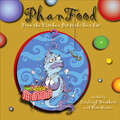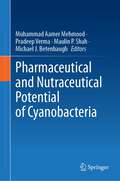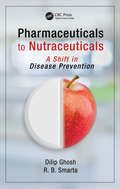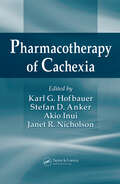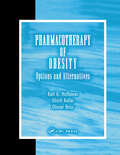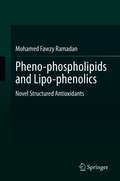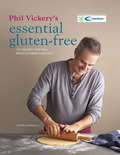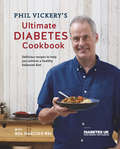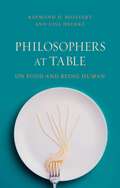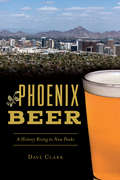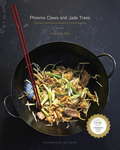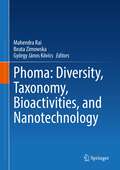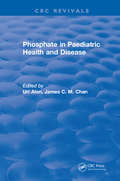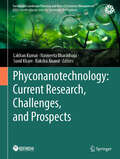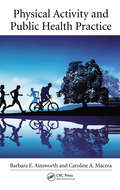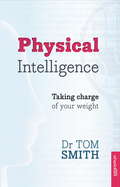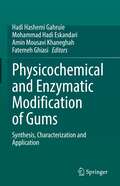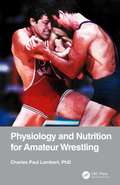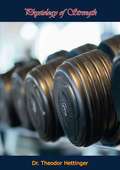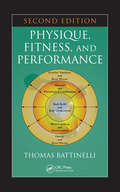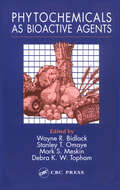- Table View
- List View
PhanFood: From the Kitchen Pot to the Tour Lot (Excelsior Editions)
by Taraleigh Weathers Pete MasonLike the band they follow from city to city, Phish fans have their own history of creativity, which in turn follows them wherever they go—even into the kitchen. Edited by Taraleigh Weathers (Healthy Hippie Magazine) and Pete Mason (Phanart: The Art of the Fans of Phish), PhanFood bring together many of the recipes that Phish fans have made and shared over the years. Included are appetizers, salads, soups, sandwiches, entrees, desserts, drinks (with and without alcohol), and a variety of other concoctions that Phish fans enjoy while they are in the lots, at the site, or just sitting at home waiting for the next tour to be announced. PhanFood is also a wholly nonprofit endeavor, with all net profits being donated to regional food banks and charities in the cities where Phish plays. A cookbook by Phish fans and for Phish fans (as well as anyone else who likes good, healthy food), PhanFood aims to benefit the Phish community and to give back to the communities Phish fans visit as they follow the band to the next great show!Taraleigh Weathers is a graduate of the Institute for Integrative Nutrition and the publisher and editor of Healthy Hippie Magazine. She lives in Burlington, Vermont.Peter Mason is a Special Education teacher and the author of Phanart: The Art of the Fans of Phish. He lives in Albany, New York
Pharmaceutical and Nutraceutical Potential of Cyanobacteria
by Maulin P. Shah Pradeep Verma Michael J. Betenbaugh Muhammad Aamer MehmoodCyanobacteria are the extraordinary microbes that are believed to have started life on Earth. It's been billions of years since they colonized this planet. Now, the question arises, what has made them so successful? The answer to this question lies in their remarkable potential to survive unfavorable environments, their substantial ability to fix the atmospheric carbon through photosynthesis, and their amazing secondary metabolites having antioxidant, osmo-protectants, and stress-tolerance abilities. Research on cyanobacteria has shown that these secondary metabolites and the substantial photosynthetic rates of cyanobacteria can be exploited for environmental, industrial, nutraceutical, and pharmaceutical applications. This book “Pharmaceutical and Nutraceutical Potential of Cyanobacteria” is a collection of 14 book chapters that have covered almost all aspects related to the opportunities, challenges, and potential applications whileemploying cyanobacteria as feedstock for various industrial and environmental applications with a special focus on pharmaceutical and nutraceutical applications. Some sections have also covered the enhanced biosynthesis, extraction, storage, and marketing of the cyanobacterial bioactive compounds (phycobilins, carotenoids, fatty acids, amino acids), and applications of cyanobacteria as food/feed of the future. We believe that this book will provide substantial learning opportunities to the readers including graduate students, academicians, phycologists, policymakers, environmental entrepreneurs, and industrialists. This book could be included in SDG 12 publications.
Pharmaceuticals to Nutraceuticals: A Shift in Disease Prevention
by Dilip Ghosh R. B. SmartaRecently, there has been a fundamental shift in the global health and wellness industry from disease treatment to preventing chronic diseases. The use of nutraceuticals and functional foods in prevention efforts could lead to a decreased dependency on drugs. The pharmaceutical industry recognizes this shift; however, serious concerns have arisen regarding the claimed efficacy, quality, and safety of products used as medical foods. This book examines the consumer and industry mindshift, including the scientific evidence of these foods as effective adjuncts to pharmacotherapy during all stages of treatment of various diseases, thus indicating that pharmaceuticals and nutraceuticals can and should coexist. It details quality, safety, and efficacy of foods, drugs, and nutrients; marketing and product positioning; regulatory perspectives; biomarkers and metabolites; probiotics; food/drug interactions; and future industry trends. In addition, food bioactives represent diet-based molecules that perform physiological roles related to disease prevention and treatment. As such, a considerable overlap exists between food bioactives and drugs—this book presents the case for comparing and contrasting foods versus drugs in several models of health and disease.
Pharmacotherapy of Cachexia
by Akio Inui Karl G. Hofbauer Stefan D. Anker Janet R. NicholsonAlthough a wealth of information can be found scattered throughout periodicals and research papers, tracking down the most effective treatment for a heterogeneous syndrome such as cachexia can be problematic. Edited by experts in the field, with contributions from a multidisciplinary panel, Pharmacotherapy of Cachexia is the first book devoted sole
Pharmacotherapy of Obesity: Options and Alternatives
by Ulrich Keller Karl G. Hofbauer Olivier BossPrimarily intended for physicians and health care professionals who are treating obese patients, this book explores current and future options for drug treatment of obesity puts them into perspective against available alternative treatments. Distinguished scientists and clinical investigators provide reviews of each individual topic, covering a wide range of subjects from pathophysiology of obesity to the benefits of weight loss. The core sections on pharmacotherapy deal with currently available drugs and drugs in pre-clinical development. These sections are complemented with sections on non-drug treatment and general therapeutic aspects. This design provides an integrated view of therapeutic approaches to the treatment of obesity and its associated syndromes.
Pheno-phospholipids and Lipo-phenolics: Novel Structured Antioxidants
by Mohamed Fawzy RamadanNatural phenolics are powerful bioactive compounds, but their use as antioxidant agents in lipid-based foodstuffs and cosmetics is limited due to their hydrophilic traits. A promising technique to overcome low solubility of phenolics is to increase their hydrophobicity by grafting with lipophilic moiety to form lipid-enriched phenolics (lipo-phenolics). Another way to enhance the amphiphilic traits of phenolics is by lipophilization with phospholipids in a suitable solvent to form phenolics-enriched phospholipids (pheno-phospholipids). Both functionalized phenolics (phenolipids) exhibit high bioavailability and antioxidative potential. Functional phenolics-enriched phospholipids (pheno-phospholipids) play an important role in enhancing the functional properties of both phenolic compounds and phospholipids in food for their use in nutrition and health. Phenolipids have also found applications on an industrial scale, likely due to low costs, the availability of starting material and safety. Recent advances in the field of lipophilization allow accessing molecules with high potency and targeted action covering a wide spectrum of bioactivities. Owing to their cost and availability, phenolipids find applications in niche sectors such as cosmetics and pharmaceutics as well as in the novel food. This book reports on the chemistry, preparation, and functionality of lipid-enriched phenolics (lipo-phenolics), broadening their applications in food, pharmaceuticals and cosmetics. The strategies of the lipophilization of phenolics, the effect of modification on the biological properties and potential applications of the resulting lipo-phenolics are reviewed. The text also discusses the preparation, physicochemical characteristics and functional properties of phenolipids and phytosomes, including the latest developments and their current industrial status.
Phil Vickery's Essential Gluten Free
by Phil VickerySince Phil Vickery published his first gluten-free book in 2009, the number of people opting to go gluten-free has risen dramatically - 13% of the UK population now say they avoid gluten; in Finland the number of coeliacs has more than doubled in 20 years and in Italy it has doubled since 2007. A notoriously restrictive diet, it can seem the end of exciting food, but Phil uses his Michelin-starred cooking talents and simple, honest ingredients to create dishes that everyone in the family can eat - including the pizza, bread, pasta, cakes and biscuits that you thought you would never enjoy again. The 175 delicious recipes take their inspiration from cuisines around the world and range from Lasagnette with Asparagus and Tomatoes to Easy Pad Thai Noodles and American-style Pancakes with Pears and Almonds.
Phil Vickery's Essential Gluten Free
by Phil VickerySince Phil Vickery published his first gluten-free book in 2009, the number of people opting to go gluten-free has risen dramatically - 13% of the UK population now say they avoid gluten; in Finland the number of coeliacs has more than doubled in 20 years and in Italy it has doubled since 2007. A notoriously restrictive diet, it can seem the end of exciting food, but Phil uses his Michelin-starred cooking talents and simple, honest ingredients to create dishes that everyone in the family can eat - including the pizza, bread, pasta, cakes and biscuits that you thought you would never enjoy again. The 175 delicious recipes take their inspiration from cuisines around the world and range from Lasagnette with Asparagus and Tomatoes to Easy Pad Thai Noodles and American-style Pancakes with Pears and Almonds.
Phil Vickery's Ultimate Diabetes Cookbook: Delicipis Recipes To Help You Achieve A Healthy Balanced Dite
by Phil VickeryWinner - Gourmand World Cookbook Awards: Best World Gourmand Cookbook Health and Nutrition 2017 Being diagnosed with Type 2 Diabetes needn't mean an end to enjoying food. In his bestselling gluten-free cookbooks, Phil Vickery showed it's possible to overcome dietary restrictions and still eat well. Now he's turned his attention to creating recipes that will help diabetics take control of their diet and lower their blood sugar levels, with the endorsement of Diabetes UK. Organised into Breakfasts, Light Bites, Soup & Lunch, Main Meals, Sweet Things & Drinks and Sides & Dressings, the recipes are accompanied by nutritional analysis and at-a-glance `traffic light' labelling. They include delicious dishes such as Squash, Feta & Hazelnut Salad and Roast Butterfly Chicken with Pomegranate, Lemon, Garlic & Mint, and cakes and desserts such as Banana Pinenut Cake and Easy Chocolate Mousse. With advice on achieving (and maintaining) a healthy weight, practical tips on eating less refined carbohydrates, smaller portions, and nutrient dense ingredients, Phil makes eating sensibly easier and more appealing than ever.
Phil Vickery's Ultimate Diabetes Cookbook: Supported by Diabetes UK
by Phil VickeryWinner - Gourmand World Cookbook Awards: Best World Gourmand Cookbook Health and Nutrition 2017 Being diagnosed with Type 2 Diabetes needn't mean an end to enjoying food. In his bestselling gluten-free cookbooks, Phil Vickery showed it's possible to overcome dietary restrictions and still eat well. Now he's turned his attention to creating recipes that will help diabetics take control of their diet and lower their blood sugar levels, with the endorsement of Diabetes UK. Organised into Breakfasts, Light Bites, Soup & Lunch, Main Meals, Sweet Things & Drinks and Sides & Dressings, the recipes are accompanied by nutritional analysis and at-a-glance `traffic light' labelling. They include delicious dishes such as Squash, Feta & Hazelnut Salad and Roast Butterfly Chicken with Pomegranate, Lemon, Garlic & Mint, and cakes and desserts such as Banana Pinenut Cake and Easy Chocolate Mousse. With advice on achieving (and maintaining) a healthy weight, practical tips on eating less refined carbohydrates, smaller portions, and nutrient dense ingredients, Phil makes eating sensibly easier and more appealing than ever.
Philadelphia! (Recipe for Adventure #8)
by Giada De Laurentiis Brandi Dougherty Francesca GambatesaThe votes are in! The Bertolizzi siblings are headed to Philadelphia for their latest great culinary adventure.When Zia Donatella comes to live with the Bertolizzi family, little do Alfie and his older sister, Emilia, know what's in store for them. Zia Donatella is determined to show them how a home-cooked meal is better than even the best takeout pizza. And when Zia's plan actually transports Alfie and Emilia to famous food cities around the world, they learn firsthand how food can not only take you places but also bring you back home.In this adventure, Zia sends the entire Bertolizzi family to the city of brotherly love - Philadelphia! Known as the "birthplace of America," Philadelphia welcomes the family with its historic blend of colonial buildings, national landmarks, and equally revolutionary cuisine. Their Philadelphia tour guide, Emma, shows the family that foodie destinations like Reading Terminal Market and 9th Street have as rich a history as the Liberty Bell.
Philosophers at Table: On Food and Being Human
by Lisa Heldke Raymond D. BoisvertOne of the most important things we do every day is eat. The question of eating - what and how - may seem simple at first, but it is dense with possible interpretations, reflecting the myriad roles food plays in our lives. In fact, as Raymond D. Boisvert and Lisa Heldke show in this book, it's difficult to imagine a more philosophically charged act than eating. <p><p> Philosophers at Table explores the philosophical scaffolding that supports this crucial aspect of everyday life, showing that humans are not just creatures with minds, but creatures with stomachs. Examining a wealth of myths, literary works, histories and films - as well as philosophical ideas - the authors make the case for a philosophy of food. They look at Babette's Feast in a discussion of hospitality as a central ethical virtue. They compare eating a fast-food meal in Accra with dining at a molecular gastronomy restaurant as a way of considering the nature of food as art. And they describe biting into a slug to explore tasting as a learning tool, a way of knowing. <p><p> A surprising, original take on something we have not philosophically savoured enough, Philosophers at Table invites readers to think in fresh ways about the simple and important act of eating.
Phoenix Beer: A History Rising to New Peaks (American Palate)
by Dave ClarkPhoenix's brewing history dates back to the mid-1800s, when small breweries had to contend with brackish water, searing desert heat and no refrigeration. By the time Prohibition arrived, the state's breweries were tapped out. It wasn't until the 1930s that Arizona Brewing Company left the first indelible mark on the Copper State's thirst. When its last call came, a new force called Four Peaks rose from the ashes as majestically as the mountains for which it is named. Author Dave Clark guides you from the area's beer icons of yesterday to the rapidly evolving brewing scene of today. Discover and appreciate Phoenix beer, from the classic, clean pilsner from Helton Brewing that rivals Germany's best to Fate's local taste of the Southwest, Hatch Chile Gatos.
Phoenix Claws and Jade Trees
by Jody Horton Kian Lam KhoCreate nuanced, complex, authentic Chinese flavors at home by learning the cuisine's fundamental techniques. Phoenix Claws and Jade Trees offers a unique introduction to Chinese home cooking, demystifying it by focusing on its basic cooking methods. In outlining the differences among various techniques--such as pan-frying, oil steeping, and yin-yang frying--and instructing which one is best for particular ingredients and end results, culinary expert Kian Lam Kho provides a practical, intuitive window into this unique cuisine. Once one learns how to dry stir-fry chicken, one can then confidently apply the technique to tofu, shrimp, and any number of ingredients. Accompanied by more than 200 photographs, including helpful step-by-step images, the 158 recipes range from simple, such as Spicy Lotus Root Salad or Red Cooked Pork, to slightly more involved, including authentic General Tso's Chicken or Pork Shank Soup with Winter Bamboo. But the true brilliance behind this innovative book lies in the way it teaches the soul of Chinese cooking, enabling home cooks to master this diverse, alluring cuisine and then to re-create any tempting dish they encounter or can imagine.
Phoma: Diversity, Taxonomy, Bioactivities, and Nanotechnology
by Mahendra Rai Beata Zimowska György János KövicsThe book covers the taxonomy, diversity, bioactivity, and nanotechnology involved in the study of the genus Phoma. It presents the most recent molecular taxonomic approach, secondary metabolites, different bioactivities, combating microbial threats, and its use in nanotechnology from a basic research to an applied perspective. Expert contributors provide the latest research and applications to present thorough coverage of this important genus in human and plant pathology and the disease management.
Phosphate in Paediatric Health and Disease
by U. AlonPhosphate in Pediatric Health and Disease provides a state-of-the-art overview of normal physiology, pathophysiology, genetics, clinical and therapeutic aspects of different types of phosphate homeostasis in early life. The book reviews the developmental physiology of phosphate metabolism from the fetus to the adolescent. It describes the pathophysiologic mechanisms associated with perturbations in phosphate homeostasis as well as discusses the different clinical conditions related to abnormal mineral metabolism, parathyroid hormone and vitamin D in infancy, childhood, and adolescence, and the modern diagnostic and therapeutic modalities. This book will benefit pediatricians, endocrinologists, neurologists, nutritionists, and researchers in the field of mineral metabolism.
Phyconanotechnology: Current Research, Challenges, and Prospects (Sustainable Landscape Planning and Natural Resources Management)
by Navneeta Bharadvaja Lakhan Kumar Raksha Anand Sunil KhareThis book explores the scientific development in the field of algal-based nanomaterials synthesis, production methods, and commercial and utilization aspects of phyconanomaterials to address a range of problems of humanity. Nanomaterials have been recently explored for and employed in environmental remediation, biomedical applications, agriculture, food industries, energy sectors, cosmetics, biolabeling, and space due to their versatility and wide range of applicability owing to their peculiar material characteristics and other attributes. Their conventional synthesis approaches are replacing green methods as the latter is comparatively economical, energy-efficient, and eco-friendly. Biological entities and derived materials-based nanomaterials synthesis is such a green approach. Using natural systems to synthesize nanomaterials does not leave behind any toxic compounds generally produced as by-products when physical or chemical methods are employed. Phyconanotechnology, a green way of synthesizing nanomaterials, can be used to overcome this issue. In the proposed book, algal diversity-based nanomaterials synthesis and their applications will be presented to the readers.
Physical Activity and Public Health Practice
by Barbara E. Ainsworth Caroline A. MaceraPhysical activity remains a critical area of research as we consider cost-effective measures for lowering the chronic disease epidemic worldwide. In our increasingly automated society, many adults and children are not active at health-enhancing levels. In Physical Activity and Public Health Practice, a panel of respected researchers summarizes esse
Physical Intelligence: How To Take Charge Of Your Weight
by Tom Smith Dr Tom SmithThis book analyses the often-complex factors that influence weight gain, from our hormonal make-up to our eating psychology. Full of evidence-based research and real-life case histories, it gives intelligent advice on what to do when confronted with the need to tackle your health, or that of your child. It emphasises that exercise is key and that eating is one of the joys of life, not a medication. Topics include: Our hunter-gathering past; Exercise intelligence; Why we don't exercise enough; Hydration intelligence; Nutritional intelligence; Fasting intelligence; Antioxidants, vitamins, minerals and other supplements.
Physical Intelligence: How To Take Charge Of Your Weight
by Tom Smith Dr Tom SmithThis book analyses the often-complex factors that influence weight gain, from our hormonal make-up to our eating psychology. Full of evidence-based research and real-life case histories, it gives intelligent advice on what to do when confronted with the need to tackle your health, or that of your child. It emphasises that exercise is key and that eating is one of the joys of life, not a medication. Topics include: Our hunter-gathering past; Exercise intelligence; Why we don't exercise enough; Hydration intelligence; Nutritional intelligence; Fasting intelligence; Antioxidants, vitamins, minerals and other supplements.
Physicochemical and Enzymatic Modification of Gums: Synthesis, Characterization and Application
by Amin Mousavi Khaneghah Hadi Hashemi Gahruie Mohammad Hadi Eskandari Fatemeh GhiasiNatural gums are polysaccharides consisting of multiple sugar units linked together via glycosidic linkages. Most natural gums reveal appropriate safety for oral consumption in the form of food additives or drug carriers. Challenges related to the utilization of natural polysaccharides, however, include uncontrolled rates of hydration, pH dependent solubility, viscosity reduction during storage, and weak interfacial properties. Modification provides an efficient route for not only removing such drawbacks but also improving physicochemical properties, such as solubility, viscosity and swelling index, and introducing new properties for varied applications.This book provides a comprehensive review of the various modifications on gums to make them suitable for food, cosmetic and pharmaceutical industries. The book is divided in four parts: an introduction to natural gums followed by in-depth coverage of chemical modification, physical modification, and enzymatic modification of gums. Each chapter includes reaction mechanisms, physicochemical properties, rheological properties, interfacial properties, applications and future perspectives. Presenting a succinct account on gum modification from a practical point of view, this book is a helpful reference for academic and industrial scientists and engineers in food technology, materials chemistry, pharmaceuticals, chemical, industrial, and applied engineering, biochemistry, and biopolymers.
Physiology and Nutrition for Amateur Wrestling
by Charles Paul LambertPhysiology and Nutrition for Amateur Wrestling is essential reading for amateur wrestlers and their coaches with a desire to learn about physiological training and nutrition for their sport. Written by Charles Paul Lambert, PhD, a competitive wrestler and academic expert in high-intensity exercise, this book describes the primary physiological systems involved in amateur wrestling. Readers will learn how to substantially optimize performance and discover ways to improve body composition specific to the sport of amateur wrestling. The book addresses important issues, including relative energy deficiency in sport, debates around weight loss, the specificities of training and nutrition for female wrestlers, as well as strategies on keeping fit in the years after a competitive career. Features: Discusses strategies for monitoring overall training load to prevent overtraining and optimize training Includes optimal nutritional fueling plans for wrestlers written by a Certified Coach with USA Wrestling and compares different dietary approaches to losing weight and fat Provides optimal rehydration and refueling plans based on situational needs in the post-weigh-in period Both scientific and practical, Physiology and Nutrition for Amateur Wrestling will appeal to wrestlers, high-school and college coaches, and those working in applied physiology research and exercise science.
Physiology of Strength
by Dr Theodor Hettinger M. H. Thurlwell Prof. Arthur H. SteinhausFirst published in 1961, “[T]his book is the result of ten years of research and experiment in the problems of muscle strength and muscle training at the Max-Planck-Institut für Arbeitsphysiologie, Dortmund, Germany supplemented by further work at the Lankenau Hospital, Division of Research, Philadelphia, Pennsylvania. There is provided the present status of these problems, and there is demonstrated how muscle strength may be built and maintained with a minimum of time and effort.“The methods used are adaptable, with suitable modification, to children, to average young people, to athletes in training, to sedentary workers and older persons who wish to maintain bodily strength, and to those who have undergone surgery and need rehabilitation of the muscle structure—in short, to anyone who wishes to develop and maintain good muscle tone.“A strong and well-built body not only has pleasing appearance, it permits the undertaking of arduous physical activities or active sports without undue fatigue, and with real enjoyment.“It is the author’s hope that in this age of fast living and nervous tension, when there often seems neither time nor place for extensive exercise, this book will assist those who wish to maintain bodily strength and fitness—simply, at home, without elaborate equipment—on a do-it-yourself basis. It should prove of special benefit to teachers of physical education and rehabilitation.”—THEODOR HETTINGER, M.D.
Physique, Fitness, and Performance (Exercise Physiology)
by Thomas BattinelliTotally revised and updated, this second edition of the well-received Physique, Fitness, and Performance retains the unique integrated approach of its predecessor, examining the relationship of structure to function in human performance. Far surpassing the limited focus of standard exercise and fitness books, it combines the morphological study of
Phytochemicals as Bioactive Agents
by Mark S. Meskin Wayne R. Bidlack Stanley T. Omaye Debra K. W. TophamPhytochemicals as Bioactive Agents focuses on the mechanisms of action of phytochemicals identified as displaying bioactivity in the prevention of cancer, heart disease and other diseases and the prospects for developing functional foods containing these bioactive compounds. Internationally recognized experts present the latest research findings on the antimutagenic and anticarcinogenic effects of tea and tea constituents; chemoprevention provided by plants in the family Cruciferae and genus Allium; anticarcinogenic effects of carotenoids and curcumins; the chemistry and application of alfalfa saponins; the bioactive components of rice bran and rice oil; the effects of garlic on lowering serum cholesterol; and using phytochemicals to optimize gastrointestinal tract health and function.
